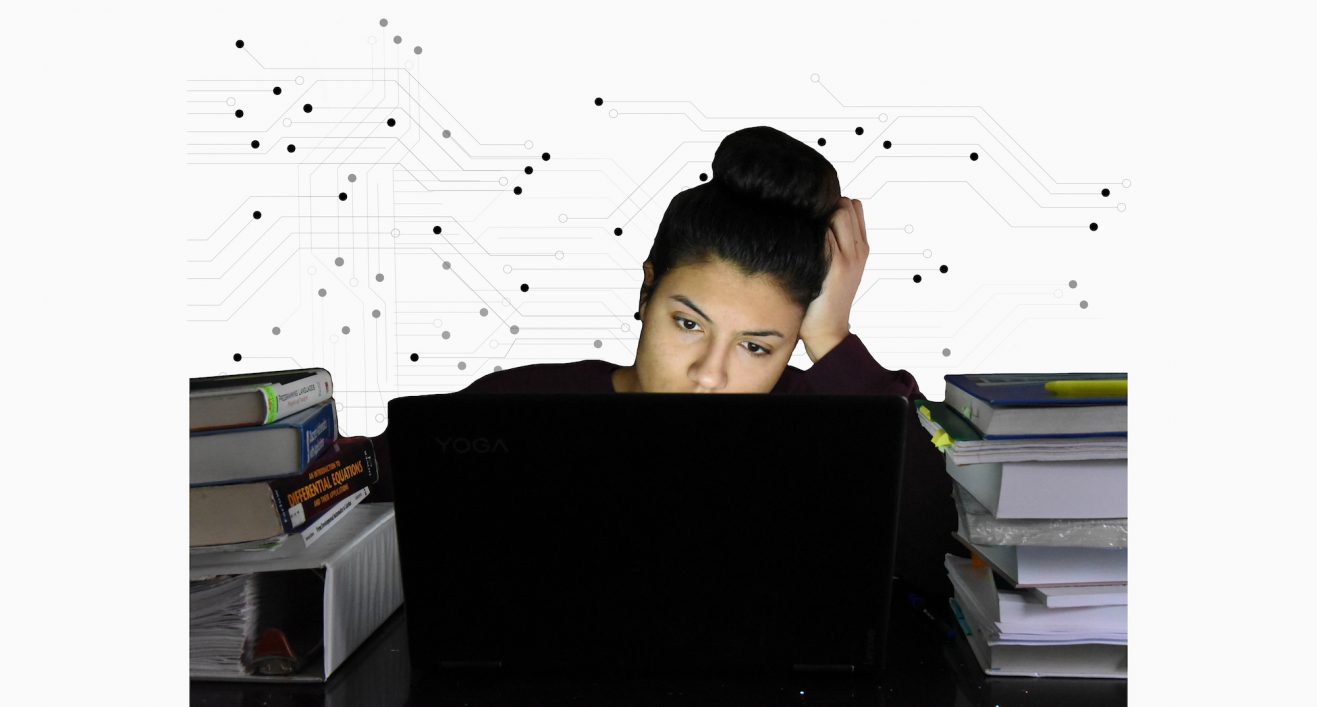When Dr. Mariajose Castellanos first heard that classes would be moving online for the two weeks following spring break due to the current outbreak of COVID-19, her initial reaction was not concern, frustration or anger. It was sadness.
“My favorite part of teaching is being with the students in the trenches,” explains Castellanos, a senior lecturer within the Department of Chemical, Biochemical and Environmental Engineering. Though she used to lecture, she has recently worked to restructure her classes to be more team-, problem- and project-based, assigning her students pre-class work so that they can spend class time working through problems together.
Now, like many other professors at the University of Maryland, Baltimore County and around the country, she will have to move those discussions to an online video-call format; she plans to use Blackboard Collaborate for full-class meetings and Webex for meetings with her class’s five-person project teams.
Blackboard Collaborate and Webex, as well as Google Hangouts, are the three synchronous learning tools that are compatible with UMBC logins, according to John Fritz, Associate Vice President for Instructional Technology. Synchronous learning is a term that refers to professors teaching in real time, while asynchronous learning refers to students watching pre-recording videos and lectures. Panopto, which Fritz describes as “a lecture-capture tool, or a screen-capture tool,” is an asynchronous teaching tool that is provided through Blackboard.
Despite the many resources at their disposal, some professors are unsure if they will be able to replicate the feeling of in-class discussions in an online space. For Dr. Lindsay DiCuirci, who is teaching a seminar in the English department called Dangerous Reading in the Early U.S., what is discussed in class each day is based largely on “where [the students] land in the various texts we’ve read for that week … We might cover a lot, or we might end up sitting with one poem.”
Over a video conference, that free-flowing approach may not result in productive conversation the same way it does in the classroom. Without the ability to “read the room,” she worries that she will not be able to tell as easily when the students find something confusing and need her to spend time explaining it, for example.
Her solution is one that most students would appreciate: She is cutting down on the number of readings in order to stage more focused and productive discussions.
“You go with what’s essential,” she explains. “We were gonna cover an entire, you know, fifty Walt Whitman poems. But the meat of what I really want people to zero in on are these ten.”
Luckily, for both DiCuirci and Castellanos, there are not any significant challenges associated with moving the content of the course online. DiCuirci, who has a background in the digital humanities, is already anticipating using blogging tools, like WordPress, and digital archives, like The Walt Whitman Archive, to create assignments that are specially suited to online learning.
Although for many, the image that comes to mind when picturing an engineering course involves tinkering with parts and building models, Castellanos’s class, Process Engineering Economics and Design II, will also not be difficult to transfer online. Because the materials required for chemical engineering design projects are prohibitively expensive, the curriculum of the class already involves using online simulations.
What may be harder to transfer are the student presentations — which, in Castellanos’s course, are delivered approximately every other week. In response to a survey Castellanos sent to all of the students within her department, a few students in her course requested that she allow them to give their presentations live, rather than submitting pre-recorded video. According to Castellanos, this is because they do not want to miss out on the chance to gain experience with presenting and improving their communication skills.
Another concern is how professors will give their exams. Test questions that are not straight-forward multiple choice or essay questions, such as math problems in which the students’ work is considered in how the question is graded, will be difficult to transfer online. And without a proctor, some professors worry that they will not be able to prevent academic dishonesty.
To those professors, Fritz recommends the Respondus LockDown Browser, which prevents students from using other functions on their computers while taking the test and records them from their webcam so that professors can tell if students are looking at notes.
Castellanos’s concerns go beyond which resources to use, however; she worries that some students will not have the time and space to take her exams in the first place. “How are they going to take an exam for two hours if they’re a mother or a father whose kids are home from school?” she asks, referring to the fact that Maryland public schools are currently closed until at least March 30.
“We can’t do exams like we used to do exams,” she says. “We have to come up with something else.”
The quest for academic continuity
Though DiCuirci and Castellanos have developed plans for the coming weeks, not every professor has the ability to dive so deeply into online learning on such short notice. Those professors are looking to the university, to their departments and to their colleagues for guidance.
One way professors are assisting one another? By acting as Academic Continuity Ambassadors.
The twenty Academic Continuity Ambassadors previously served as Blackboard Ultra Ambassadors — faculty members whom the Division of Information Technology deemed proficient enough in using Blackboard to help guide other faculty as a newer version of the site, Blackboard Ultra, is rolled out. When the news broke that courses would be moving online, the Ultra Ambassadors were asked to “expand their scope a little bit” and help their colleagues with the transition, according to Fritz.
Since then, the ambassadors have spent their days fielding and trying to help solve their colleague’s technical or pedagogical problems.
Among their ranks are Castellanos, as well as psychology professor Dr. Eileen O’Brien, who knows the ins and outs of online learning from having taught Introduction to Psychology as an online course in the past.
Different faculty have required different levels of help with the transition to distance learning: “I think it runs the range from people who haven’t even used Blackboard before” to people who are already fairly comfortable teaching from home, O’Brien says. According to Fritz, 82 percent of courses and 87 percent of professors use Blackboard to some extent.
So far, much of O’Brien’s consulting has involved teaching her colleagues about the different platforms that are available and helping them decide which platforms will work best for them. She advises professors to go with whichever tool they are most comfortable with, explaining that, “When you have to turn so many things around in a short period of time, you go with what you know.”
Castellanos, similarly, has fielded questions regarding whether a synchronous or asynchronous approach is optimal; she sees a combination of the two methods as most effective. One of her top pieces of advice is to make sure online lectures are digestible for the students. “Don’t tape 45-minutes of you talking,” she warns. “Chunk it out into littler videos: seven minutes, seven minutes, seven minutes.”
Fritz attributes the success of the Academic Continuity Ambassador initiative to the culture of UMBC, which he says promotes collaboration between professors. “Faculty learn best from other faculty, and I’m okay with that,” he explains, stating that the Department of Information Technology probably would have been overwhelmed over the past week if they had not had the ambassadors’ assistance.
That being said, DoIT is providing several types of direct support as well. In the three days preceding spring break, DoIT staff members were on hand to answer questions and solve technology-related problems for faculty. The department also delivered a webinar on that Wednesday, which 120 faculty members attended virtually, that explained tools like Panopto and Webex.
In the coming weeks, DoIT plans to continue with digital drop-in sessions, which are opportunities for professors to consult with the DoIT staff. Those will take place from 9 a.m. until noon on weekdays, and will be followed by sessions focused on specific topics in the afternoon. The schedule for these sessions can be found on the DoIT website.
Additionally, Fritz encourages professors to visit DoIT’s academic continuity webpage, which includes a wealth of resources.
“The concerns are, rightfully, the big ones.”
Now that this period of distance learning has been extended from a mere two weeks to the rest of the spring semester, UMBC students are having to contend with bigger changes than just the transition to online classes. Some are having to figure out where they will live, if not in their on-campus housing; others are trying to find work after Governor Larry Hogan ordered the closure of Maryland bars and restaurants.
Fortunately for those students, professors like DiCuirci are aware of these challenges, and are determined not to inundate students with extra stress.
“The transition to home, whatever home might mean for some people, might mean a really radical, really disruptive change to their life,” DiCuirci says. “I don’t want to surge ahead as if that disruption isn’t really there or doesn’t really matter.”
While she wants her class to be able to continue learning about and appreciating great literature, she knows that most students have other priorities at this time.
“[Students’] number one concern — and this is not a slam at students at all — is not, ‘how will we have robust discussions anymore?’” she says. “The concerns are, rightfully, the big ones.”
Understanding that, she feels, is important to making it through this unusual semester with as little strife as possible.



